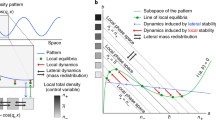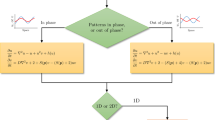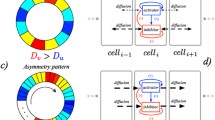Abstract
Turing's model of pattern formation has been extensively studied analytically and numerically, and there is recent experimental evidence that it may apply in certain chemical systems. The model is based on the assumption that all reacting species obey the same type of boundary condition pointwise on the boundary. We call these scalar boundary conditions. Here we study mixed or nonscalar boundary conditions, under which different species satisfy different boundary conditions at any point on the boundary, and show that qualitatively new phenomena arise in this case. For example, we show that there may be multiple solutions at arbitrarily small lengths under mixed boundary conditions, whereas the solution is unique under homogeneous scalar boundary conditions. Moreover, even when the same solution exists under scalar and mixed boundary conditions, its stability may be different in the two cases. We also show that mixed boundary conditions can reduce the sensitivity of patterns to domain changes.
Similar content being viewed by others
References
Ashkenazi, M., Othmer, H. G.: Spatial patterns in coupled biochemical oscillators. J. Math. Biol. 5, 305–350 (1978)
Babloyantz, A., Bellemans, A.: Pattern regulation in reaction-diffusion systems — the problem of size invariance. Bull. Math. Biol. 47, 475–487 (1985)
Benson, D. L., Sherratt, J. A., Maini, P. K.: Diffusion driven instability in an inhomogeneous domain. Bull. Math. Biol. 55, 365–384 (1993)
Benson, D. L., Maim, P. K., Sherratt, J. A.: Pattern formation in heterogeneous domains. In: Othmer, H. G., Maini, P. K., Murray, J. D. (eds.) Experimental and Theoretical Advances in Biological Pattern Formation. London: Plenum 1993
Brümmer, F., Zempel, G., Buhle, P., Stein, J-C., Hulser, D. F.: Retinoic acid modulates gap junction permeability: a comparative study of dye spreading and ionic coupling in cultured cells. Exp. Cell Res. 196, 158–163 (1991)
Castets, V., Dulos, E., De Kepper, P.: Experimental evidence of a sustained standing Turing-type nonequilibrium chemical pattern. Phys. Rev. Lett. 64(24), 2953–2956 (1990)
Child, C. M.: Patterns and Problems of Development. University of Chicago Press, 1941
Conway, E., Hoff D., Smoller, J.: Large time behavior of solutions of nonlinear reaction diffusion equations. SIAM J. Appl. Math. 35(1), 1–16 (July 1978)
Crick, F. H.: Diffusion in embryogenesis. Nature 225, 420–422 (1970)
10.Dillon, R., Othmer, H. G.: Control of gap junction permeability can control pattern formation in limb development. In: Othmer, H. G., Maini, P. K., Murray, J. D. (eds.) Experimental and Theoretical Advances in Biological Pattern Formation. London: Plenum 1993
Doedel, E.: AUTO: Software for continuation and bifurcation problems in ordinary differential equations. Technical report, California Institute of Technology, 1986
Driesch, H.: Entwicklungsmechanische Studien. Z. Wiss. Zool. 53, 160–184 (1892)
Driesch, H.: Entwicklungsmechanische Studien. Z. Wiss. Zool. 55, 3–61 (1893)
Epstein, I. R., Lengyel, I., Kádár, S., Kagan, M., Yokoyama, M.: New systems for pattern formation studies. Physica A, 188, 26–33 (1992)
French, V., Bryant, P. J., Bryant, S. V.: Pattern regulation in epimorphic fields. Science 193, 969–981 (1977)
Goodwin, B. C., Kaufflnan, S. A.: Spatial harmonics and pattern specification in early Drosophila development. Part I. Bifurcation sequences and gene expression. J. Theor. Biol. 144, 303–319 (1990)
Hunding, A., Sorensen, P. G.: Size adaptation of Turing prepatterns. J. Math. Biol. 26, 27–39 (1988)
Lacalli, T. C., Harrison, L. G.: The regulatory capacity of Turing's model for morphogenesis with application to slime moulds. J. Theor. Biol. 70, 273–295 (1978)
Lengyel, I., Epstein, I.R.: A chemical approach to designing Turing patterns in reaction-diffusion systems. Proc. Natl. Acad. Sci. 89, 3977–3979 (1992).
Meinhardt, H.: Modes of Biological Pattern Formation. London: Academic Press 1982
Moler, C. B., Stewart, G. W.: An algorithm for generalized matrix eigenproblems. SIAM J. Numer. Anal. 10, 241–256 (1973)
Murray, J. D.: Mathematical Biology. Berlin Heidelberg New York: Springer 1989
Othmer, H. G.: Interactions of Reaction and Diffusion in Open Systems. PhD thesis, Minneapolis: University of Minnesota 1969
Othmer, H. G.: Current problems in pattern formation. In: Levin, S. A. (ed.) (Some mathematical questions in biology VIII. Lect. Math. Life Sci., vol. 9, pp. 57–85) Providence, RI: Am. Math. Soc. 1977
Othmer, H. G.: Applications of bifurcation theory in the analysis of spatial and temporal pattern formation. In: Gurel, O., Rössler, O. K. (eds.) Bifurcation theory and applications in scientific disciplines, pp. 64–77. New York: New York Academy of Sciences 1979
Othmer, H. G.: Synchronized and differentiated modes of cellular dynamics. In: Haken, H. (eds.) Dynamics of Synergetic Systems. Berlin Heidelberg New York: Springer 1980
Othmer, H. G.: The interaction of structure and dynamics in chemical reaction networks. In: Ebert, K. H., Deuflhard, P., Jager, W. (eds.) Modelling of Chemical Reaction Systems, pp. 1–19 Berlin Heidelberg New York: Springer 1981
Othmer, H. G., Aldridge, J.: The effects of cell density and metabolite flux on cellular dynamics. J. Math. Biol. 5, 169–200 (1978)
Othmer, H. G., Pate, E. F.: Scale invariance in reaction-diffusion models of spatial pattern formation. Proc. Nat. Acad. Sci. 77, 4180–4184 (1980)
Othmer, H. G., Scriven, L. E.: Interactions of reaction and diffusion in open systems. Ind. Eng. Chem. Fund 8, 302–315 (1969)
Ouyang, Q., Swinney, H. L.: Transition from a uniform state to hexagonal and striped patterns. Nature 352, 610–612 (1991)
Pate, E., Othmer, H. G.: Applications of a model for scale-invariant pattern formation in developing systems. Differentiation 28, 1–8 (1984)
Pearson, J. E., Horsthemke, W.: Turing instabilities with nearly equal diffusion coefficients. J. Chem. Phys. 90(3), 1588–1599 (1989)
Turing, A. M.: The chemical basis of morphogenesis. Philos., Trans. R. Soc. Lond Ser. B 237, 37–72 (1952)
Ward, R. C.: The combination shift QZ algorithm. SIAM J. Numer. Anal. 12, 835–853 (1975)
Wolpert, L.: Positional information and the spatial pattern of cellular differentiation. J. Theor. Biol. 25, 1–47 (1969)
Wolpert, L.: Positional information and pattern formation. Curr. Top. Dev. Biol. 6, 183–224 (1971)
Wright, D. A., Lawrence, P. A.: Regeneration of the segment boundary in Oncopeltus. Dev. Biol. 85, 317–327 (1981)
Author information
Authors and Affiliations
Additional information
Supported in part by NIH Grant # GM29123
Rights and permissions
About this article
Cite this article
Dillon, R., Maini, P.K. & Othmer, H.G. Pattern formation in generalized Turing systems. J. Math. Biol. 32, 345–393 (1994). https://doi.org/10.1007/BF00160165
Received:
Revised:
Issue Date:
DOI: https://doi.org/10.1007/BF00160165




